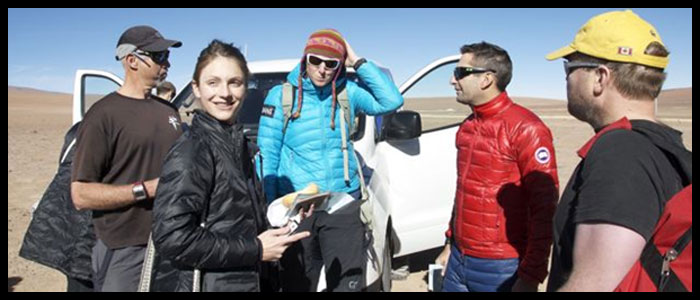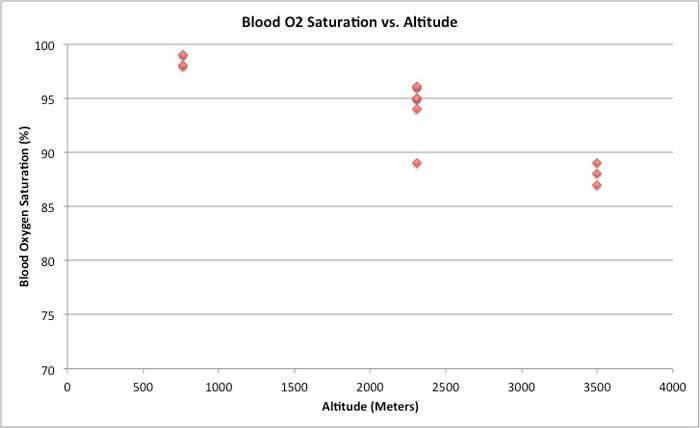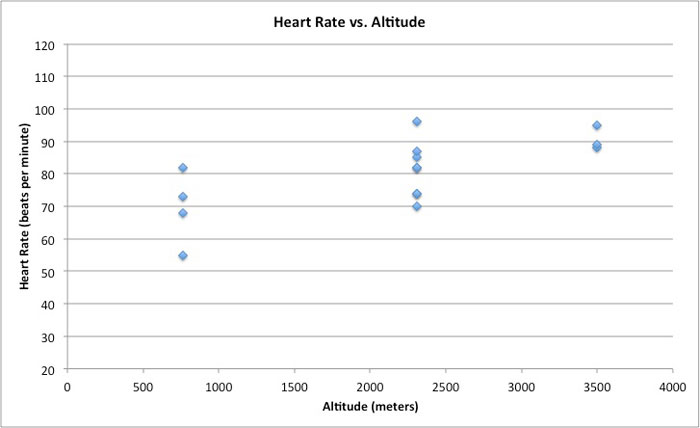
BLOOD OXYGEN SATURATION EXPERIMENTS
Date
May 13-15
Purpose
To study the effects of altitude on the human body's oxygen levels.
Discussion
Oxygen is the most important element for life. Without oxygen we die within minutes. Our entire cardio-pulmonary system is designed to transport oxygen from the environment to the cells in our body that use oxygen to create the energy that in turn fuels metabolism in every part of our body. Our trip to Bolivia will provide us with an excellent opportunity to understand oxygen metabolism in the human body.
Method
Expedition members will have their blood oxygen levels measured using a blood analyzer called an ISTAT. We will also measure blood oxygen saturation using "pulse oximetry". This will be measured at lower elevations and again as we move to altitude.
School Exercise
Students can follow the expedition and track the altitude that the members are exposed to. Using the calculators and steps provided on the site, students will be able to calculate the PO2 in the air where the expedition is taking place and then predict the levels of oxygen in our blood. We will post the real data so that students can check their predictions against our real data.
Web resource: http://www.ventworld.com/resources/oxydisso/oxydisso.html
Experiment Report & Results
Well we are now at the Salar getting ready to run! The team has taken planes and SUV's to get here. We have been gradually climbing to higher and higher elevations throughout our journey - today we peaked out at 4600 meters during our drive! That was pretty rough - most of us felt pretty dizzy and had some slight headaches. Breathing was definitely harder and even walking around during driving breaks was pretty tough. Here is a picture of the group on a break:

At increasing distances above sea level, barometric pressure, temperature, and relative humidity decrease. The decrease in barometric pressure results in a decrease in the partial pressure of atmospheric gases. When you journey from sea level to higher altitude, the total pressure of the atmosphere decreases because the weight of the air above you at high altitudes is lower. At sea level, for example, the weight of the earth's atmosphere exerts a barometric pressure equal to about 760 mmHg. This situation is not the case, however, here in Bolivia where the barometric pressure is much lower - actually 35% lower.
The decrease in barometric pressure results in a decrease in the partial pressure of atmospheric gases. But the percentage concentration of each gas that makes up air stays the same. For example, the percentage of oxygen in the air is the same at sea level and at the Salar - it is always about 21% (the rest is mostly nitrogen).
So if you are interested - you can calculate the Barometric pressure here in the Salar. Then, considering that the percentage of oxygen is always 21% - what is the partial pressure of oxygen at sea level - and here in the Salar?
Although there is as much oxygen in the air, there is less partial pressure of oxygen in the lungs to drive oxygen into our blood. As a result our blood can become desaturated of oxygen at high altitude.
Here is the data from our blood oxygen measurements:

Each dot represents one of the youth ambassadors (sometimes they had the same results so there may not always be 5 data points). The measurements from 500m were taken at the airport in Santiago, from 2300m at San Pedro de Atacama, and the 3500m was taken at the edge of the Salar.
You can see that as we are climbing in elevation, our oxygen saturation is dropping. When we went over 4600m in the truck today, some of us dropped down to 69%. Here is a picture of us doing those measurements in the truck:

The low O2 saturation was pretty uncomfortable. But fortunately our bodies adapt very quickly. To keep oxygen flowing to the brain, organs and muscles the body increases our heart rate to pump more blood through the body. Here are our heart rate results:

If we transported someone from sea level and dropped them off on the top of Mount Everest they would collapse, lose consciousness and probably die relatively quickly. But people climb Everest with some regularity now. This achievement is possible because the body responds to changes in its environment and adapts. That is what we are counting on here in Bolivia! I'll show you some really cool data in the next post that will highlight how our bodies are adapting to being at altitude.
-- Greg Wells, PhD.
« Back to Science Of The Run







